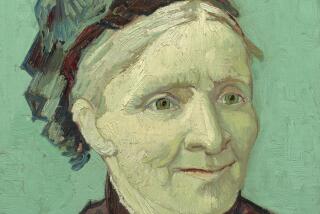Ancient Japanese Garment Fasteners Haven’t Lost Their Appeal, as an O.C. Netsuke Exhibit Will Show
- Share via
Hear no evil, see no evil, speak no evil. The familiar trio of monkeys offers a lesson even as it elicits a chuckle or two.
But “The Some-Evil Monkey”--one of more than 500 tiny carvings included in “Contemporary Netsuke: Miniature Sculpture From Japan and Beyond,” at the Bowers Museum of Cultural Art in Santa Ana starting Tuesday--provides an even more amusing, and more penetrating, glimpse into human nature. A female monkey covers one eye, one ear and only part of her mouth so that she can still see and hear a little evil, and maybe even talk a bit about it.
Better to keep both eyes open at this show, which features work by 100 artists from around the world. Japanese artist Kangyoku Tachihara’s all-too-human monkey also provides an example of a characteristic of netsuke that Prince Norihito Takamado of Japan values most. (Takamado describes himself as “smitten” with netsuke.)
“What I look for . . . is what I call a ‘twist,’ ” Takamado writes in his forward to the show catalog. He’s referring both to a twist in the design, such as a rounding of protruding elements, and, more important, to a conceptual twist.
“There are a number of netsuke that can only be understood when viewed in another way, such that understanding brings a warm smile or a little laugh,” he continues. “In contemporary pieces, too, the titles quite often conceal a pun or hidden meaning that shed new light on the work as a whole.”
Not even in Japan has there been a contemporary netsuke exhibition of this scope. Because of its size, the Bowers show will be presented in two installments, with the second installment replacing the first on April 27. It closes July 27.
The objects’ sizes range from about an inch to almost 9 inches, with most around 2 inches. They’re drawn from private American and Japanese collections, primarily from that of Robert and Miriam Kinsey of Los Angeles, who wrote the show catalog and whose enthusiasm for the art form is widely considered to have inspired a revitalization of an otherwise dying art form.
The form has its roots in traditional Japanese garb. Kimonos did not have pockets. Women carried personal accessories in their sleeves, while men tied items to toggled cords suspended from the obi, or sash; the netsuke was the toggle. (The show also includes examples of ojime and sagemono, fasteners and containers used in conjunction with the toggle.)
When Japan opened up to foreign trade in the mid-19th century, the kimono gradually gave way to Western dress. But even as the usefulness of netsuke waned, foreigners became increasingly fascinated. Masterpieces as well as mass-produced items found their way abroad, but overall quality inevitably declined.
*
Before the 1960s, the genre was much as it had been for centuries. Then Robert Kinsey, the leading collector of contemporary netsuke, put out a clarion call for carvers to go beyond traditional confines and to express their own time and circumstances. New ideas were further encouraged when the ivory trade was banned in 1989 and carvers turned to new materials including fossil mammoth tusk, hippopotamus tooth and briar.
According to Janet Baker, Bowers curator of Asian art, netsuke carving has changed from an ancient Japanese craft into an international modern art form involving practitioners from the United States, England, Austria, New Zealand, Australia and Canada. Nearly 40 artists in the upcoming show are not Japanese.
“It’s extraordinary that something so traditional and so functional be transformed into an art form that is neither traditional nor functional but highly expressive and individual,” Baker noted. “It’s also extraordinary to see that contemporary artists are interested enough to work within the existing confines. Netsuke is still restricted to a tiny scale and more or less to a form such that it could function as a netsuke if it had to.
“There’s an unusual balance between new and old, between Japanese tradition and Western expressionism,” she continued. “I’m hard-pressed to think of a parallel. So many art forms either stay traditional and become stagnant, repetitive and moribund--sort of artsy-craftsy, done by anonymous craftsmen, cranked out as souvenirs--or they basically die out altogether. Netsuke has done neither.”
In fact, according to Kinsey, the value of contemporary netsuke by the better-known artists has skyrocketed, although not to the extent of the older pieces.
“Antique netsuke have gone crazy,” Kinsey said. “A couple [of items] have sold for a quarter-million dollars apiece. The highest price paid for contemporary netsuke is somewhere around $25,000 to $30,000. When we first started you could get the darn things for 50 bucks or 100 bucks.”
The most popular subjects depicted in netsuke, ojime and sagemono remain the 12 zodiac animals, he said. Other subjects include what he calls nature’s “four Bs”--beasts, birds, bugs and blossoms--as well as saints and demons.
Takamado’s “twists” are to be found in every genre.
Japanese mothers warn children that if they don’t tell the truth, Emma-O, demon king of Buddhist hell, will pull out their tongues. In “King of Hell’s Lie,” artist Masatoshi Nakamura reverses the situation: Emma-O’s helper-in-charge-of-the-pincers has accused Emma-O of untruthfulness and is pulling out his tongue.
Hidden inside “Salmon Roe Sushi,” by Kiho Takagi, is a carving of a miniature red dachshund named Sushi-san, whom the artist met during a visit to the United States.
Guy Shaw’s “Charred Love Letters” portrays a ribbon-tied bundle of letters, one corner of which is charred. The recipient had apparently decided to burn them, but changed her mind. (It’s the viewer’s imagination that catches fire.)
Kinsey especially prizes a netsuke by Meigyokusai Hiraga that shows a monkey examining a netsuke that portrays a monkey. The carving captures the moment of enlightenment when the monkey, who is wearing glasses, notices the family resemblance.
Kinsey owns other Japanese art objects based on the same idea, and has seen it on boxes, porcelain and paintings. “The monkeys always seem to have the glasses, [in order] to see more clearly,” Kinsey said with a chuckle.
For the most part, Netsuke are as round as possible and should be beautiful from any angle. Kinsey believes that the attraction is more fundamental than hidden meanings.
“Every piece of sculpture, no matter what the size or material, depends on the light you have when you view it, and the angle from which you view it,” he said. “The Lincoln Memorial, if you catch it in the ideal sunlight, and at just the right angle, is absolutely magnificent--it comes to life. At other times of day, it’s just a piece of sculpture.
“The advantage of netsuke is that it’s very small,” Kinsey said. “You can change it in your hand to find the ideal angle or move it to find the ideal light. You can even take a magnifying glass to it. It has tactile appeal and visual appeal--and it has all kinds of connotations carved into it.”
* “Contemporary Netsuke: Miniature Sculpture From Japan and Beyond” opens Tuesday and runs through July 27 at the Bowers Museum of Cultural Art, 2002 N. Main St., Santa Ana. Adults $6, seniors and students $4, children 5-12 $2 (includes same-day admission to Kidseum). (714) 567-3600.
More to Read
The biggest entertainment stories
Get our big stories about Hollywood, film, television, music, arts, culture and more right in your inbox as soon as they publish.
You may occasionally receive promotional content from the Los Angeles Times.










